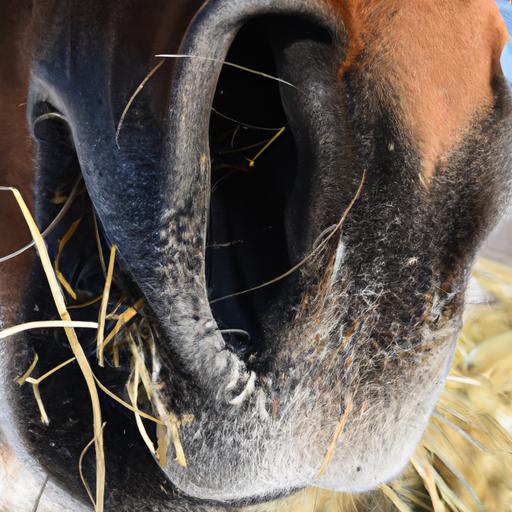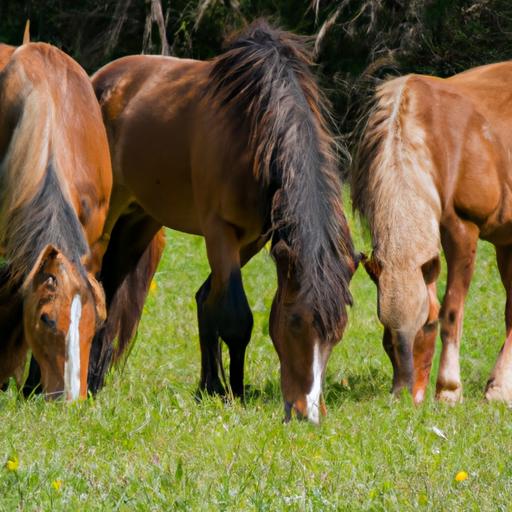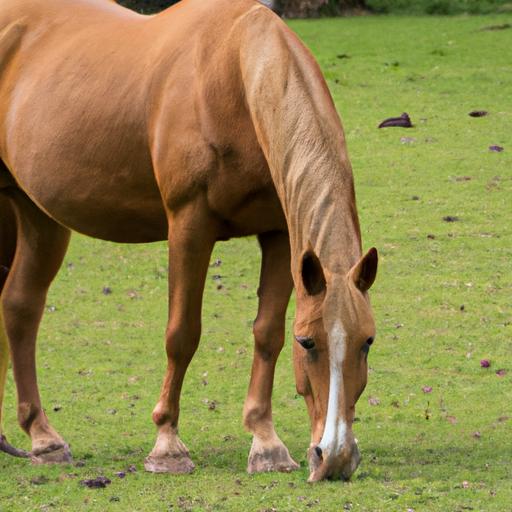Unlock the secrets of a horse’s normal feeding behavior! Learn about their dietary needs, signs of health issues, and behavioral indicators in this informative article.

As an equestrian enthusiast, have you ever wondered why understanding the normal feeding behavior of a horse is crucial? Well, let me guide you through the fascinating world of equine nutrition. By unraveling the secrets behind a horse’s feeding habits, we can lay the foundation for optimal health and well-being. So, let’s embark on this enlightening journey together!
Introduction

A. Importance of Understanding the Normal Feeding Behavior of a Horse
The feeding behavior of horses is not merely a mundane aspect of their lives; it is a fundamental pillar that supports their overall health. By comprehending their natural feeding habits, we can design appropriate diets, prevent potential health issues, and promote their well-being. After all, a well-fed horse is a happy and thriving horse.
B. Brief Overview of a Horse’s Digestive System
Before we delve into the intricacies of equine feeding behavior, let’s take a moment to understand the remarkable digestive system of these majestic creatures. Horses possess a unique gastrointestinal tract designed to efficiently process their herbivorous diet. From the moment food enters their mouth, a series of sophisticated mechanisms kick into gear, ensuring optimal nutrient absorption and energy production.
In conclusion, unlocking the secrets of a horse’s normal feeding behavior is paramount to their overall health and happiness. By gaining insights into their natural grazing and foraging habits, we can tailor their diets accordingly, preventing potential health issues and fostering their well-being. So, join me on this enlightening journey as we explore the fascinating world of equine nutrition.
Stay tuned for the upcoming sections where we will uncover the natural feeding habits of horses, explore their dietary needs, and delve into effective feeding management practices. Remember, at Horsemasterypro.com, we are dedicated to providing you with the knowledge you need to become a true master of equine care.
Natural Feeding Habits of Horses

A. Grazing Behavior
When we envision a horse contentedly grazing in a picturesque pasture, we are witnessing their innate grazing behavior at play. It is fascinating to observe how horses instinctively engage in specific patterns while feeding.
1. Description of Grazing Patterns
Horses have a natural inclination to graze in a circular or elliptical pattern, moving steadily as they consume grass. This circular movement allows them to evenly distribute their grazing pressure, preventing overgrazing in certain areas. Furthermore, their grazing pattern aids in maintaining a healthy pasture ecosystem by promoting grass regrowth and preventing soil erosion.
2. Time Spent Grazing
Grazing is not just a means of acquiring sustenance for horses; it is also a significant part of their daily routine. On average, horses spend approximately 16 to 18 hours per day engaged in grazing activities. This prolonged exposure to grazing is essential for both their physical and mental well-being.
B. Foraging Behavior
In addition to grazing, horses exhibit foraging behavior, which involves actively searching for and selecting suitable plants to consume. This behavior closely aligns with their natural instincts as herbivores.
1. Searching for Food
Horses have a keen sense of smell and an acute ability to detect desirable forage. They actively explore their surroundings, using their mobile upper lip to delicately sniff and select the most palatable plants. This foraging behavior allows horses to satisfy their nutritional needs while maintaining a diverse and balanced diet.
2. Selecting Suitable Plants
Horses possess an innate ability to differentiate between safe and potentially toxic plants. Through trial and error, as well as maternal guidance, they learn to avoid harmful vegetation. This selective foraging behavior ensures that horses consume a variety of plants that provide the necessary nutrients for their overall health.
In conclusion, understanding the natural feeding habits of horses is key to providing them with an environment that supports their instinctive behaviors. By recognizing and accommodating their grazing and foraging habits, we can enhance their well-being and ensure they receive a nutritionally balanced diet. Join us in the next section as we uncover the essential nutrients horses require for optimal health and vitality.
Feeding Management Practices
Feeding a horse goes beyond simply providing sustenance; it involves careful consideration of feed type, quality, and appropriate portioning. Let’s explore the essential aspects of feeding management that ensure your horse receives the nutrition it needs to thrive.
A. Feed Type and Quality
When it comes to feed, selecting the right type and ensuring its quality is crucial for meeting a horse’s dietary requirements. Here are three key feed types to consider:
-
Hay: Hay is a staple in a horse’s diet, providing essential fiber and nutrients. Varieties such as timothy, alfalfa, and orchard grass are commonly used. Aim for high-quality hay that is free from mold, dust, and weeds to promote optimal health.
-
Pasture: Allowing your horse access to pasture is not only beneficial for their physical and mental well-being, but it also provides them with a natural source of nutrition. Ensure the pasture is well-maintained, free from toxic plants, and offers a variety of grasses for a balanced diet.
-
Concentrates: Concentrates, such as grains and pellets, can be used to supplement a horse’s diet when additional nutrition is needed. However, it’s important to choose concentrates specifically formulated for horses and to feed them in moderation to maintain a balanced diet.
B. Feeding Frequency and Quantity
Establishing a consistent feeding schedule and determining appropriate portion sizes is essential for a horse’s health. Consider the following guidelines:
-
Recommended Feeding Schedule: Horses generally thrive on a feeding schedule that includes multiple smaller meals throughout the day, mimicking their natural grazing behavior. Aim for at least two to three feedings per day, spacing them out evenly to promote digestion and prevent overeating.
-
Determining Appropriate Portion Sizes: The amount of feed a horse requires depends on several factors, including age, weight, activity level, and overall health. Consult with a veterinarian or equine nutritionist to determine the appropriate portion sizes for your horse. Consider the nutritional content of the feed and adjust portions accordingly to maintain a healthy weight.
In conclusion, effective feeding management practices encompass choosing the right feed types, ensuring their quality, establishing a consistent feeding schedule, and determining appropriate portion sizes. By implementing these practices, you can provide your horse with the nutrition it needs to thrive and maintain optimal health.
Stay tuned for the upcoming sections where we will explore how to recognize abnormal feeding behaviors in horses and discover strategies for promoting healthy feeding habits. At Horsemasterypro.com, we are committed to empowering you with the knowledge and skills to become a master of equine care.
Conclusion: Nurturing the Well-being of Your Equine Companion
Throughout this enlightening exploration of a horse’s normal feeding behavior, we have uncovered the key to unlocking their optimal health and well-being. Understanding their natural grazing and foraging habits, as well as their dietary needs, allows us to provide them with the nourishment they require to thrive.
By recognizing the signs of abnormal feeding behavior, such as weight loss or gain, changes in appetite, dental problems, and behavioral indicators like aggressive or disruptive eating habits and pica, we can promptly address potential health issues. This proactive approach ensures that our equine companions receive the care they deserve, promoting their overall happiness and longevity.
At Horsemasterypro.com, we are committed to equipping you with the knowledge and expertise to become a master of equine care. Our comprehensive resources and expert guidance empower you to create a suitable feeding environment, balance your horse’s diet, and implement a well-structured feeding plan.
Remember, when it comes to the normal feeding behavior of your horse, you hold the reins. By paying attention to their needs and providing them with the nourishment they require, you can forge a deep bond and cultivate a harmonious partnership with your equine companion.
Thank you for joining us on this enlightening journey. Harness the power of understanding your horse’s feeding behavior and unlock the door to their flourishing health and happiness.
Horsemasterypro.com – Your trusted companion on the path to equine excellence.


